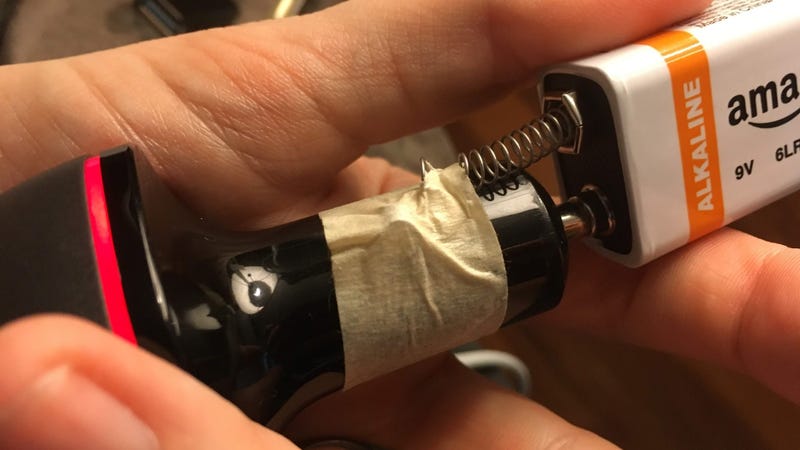
In a power outage, a 9 volt battery can give your phone enough juice to make a call or send a few texts. You may have seen this hack before, but it works especially well in this variation where you use the spring from a pen to connect the negative terminal.
You’ll need a car charger—the kind you plug into what used to be called the cigarette lighter in your car. Just grab a spring from a pen, and tape it to that little metal nub on the side of the charger, as shown in the photo above.
Advertisement
Then line up your 9 volt battery, with the big (negative) battery terminal on the spring, and the positive (smaller) terminal touching the button in the center of the car charger.
Then just hold it in place. For a while.
How long will it take?
It took me 7 minutes to charge my iPhone SE from 60 percent to 67 percent charged. The exact time it takes may vary, depending on how charged your phone is and how much juice is left in the 9-volt.
Advertisement
Your hands may get tired, but you’re free to MacGuyver up your own solution for this part: duct tape the battery to the charger, perhaps, or wedge the whole apparatus between some heavy books and the wall.
How much of a charge will I get?
A typical 9 volt battery has 500 milli-Ampere hours (mAh). Compare that to the size of your phone’s battery. A few examples:
- iPhone 8: 1,821 mAh
- iPhone 7: 1,960 mAh
- iPhone SE: 1,624 mAh (this is the phone I tested)
- Galaxy S8 or S9: 3,000 mAh
- Pixel 2: 2,700 mAh
It would take four 9-volt batteries to fully charge my little phone, or six to charge a Galaxy S9. So this isn’t a long-term solution, but it can get you that little bit of charge that can let you text your mom, or order a Lyft or, if necessary, call 911.
What if it doesn’t work?
First, make sure everything is connected. The spring should be touching the metal of the car charger’s side nub, the button on the end of the car charger (the positive terminal) may need to be pressed in, and your charging cable should be connected as usual.
Advertisement
If you have trouble getting any of these parts to stay in place, use a scrap of aluminum foil to bridge any gaps.

On a large phone with a fast-charging charger, the 9 volt battery may have trouble supplying enough voltage under load, and the charger may repeatedly start and stop. This isn’t confirmed, but it’s a theory my husband had when we tested this hack on his Moto X Pure and a charger capable of Qualcomm 2 fast-charging. So we added two AA batteries to the circuit. I used balls of aluminum foil to help the batteries make the connection, and taped them in place. (Make sure the bits of foil do not touch each other! You don’t want a short circuit!)
Advertisement
With the 9-volt alone, his phone dropped from 77 to 76 percent during five minutes of attempted charging. But a bit later, when it was at 75 percent, I managed to charge it to 77 percent in five minutes with the extra batteries.
So if you’re preparing for a storm, pick up some 9 volt batteries and make sure you have a pen around with a spring you can use. (In a pinch, you could substitute a piece of folded aluminum foil for the spring, but the spring is just really handy.)
Advertisement
That said, it’s even better if you just get a big portable battery for your phone, and make sure it’s charged before the storm comes. Don’t forget that if you have an old laptop sitting around—even if its screen is broken or it has other issues—you can charge it up and power your phone off its USB ports.
from Lifehacker http://bit.ly/2xcvGtr
via IFTTT
